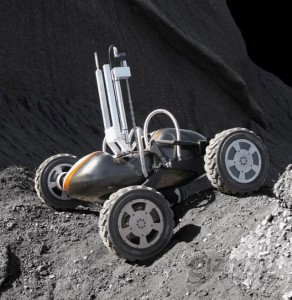Lunar Resources (Part 2): Changing our approach to spaceflight
How do we go about using the resources of the Moon and of space in general?

Last time, I outlined some of the basic principles of lunar resource utilization. The Moon is our nearest source of material resources in space and learning how to extract what we need from the Moon is a key skill in our expansion into the Solar System.
All this is very well and good, but how do we go about using the resources of the Moon and of space in general? Many people tend to think of huge industrial factories, similar to oil refineries, built on the Moon, with large mining communities similar to those depicted in the movie Outland. In fact, the beauty of space resource utilization is that it’s possible to start very small and build up capability with time. The “factory” needed to produce a metric tonne of oxygen on the Moon is the size of a typical office desk.
Mining is a very old and venerable field and has some simple precepts. First, you must find and characterize the prospect. Next, you need to understand the concentrations and physical states of the “ore body” that you wish to mine. Then you must collect the feedstock, convey it for processing, extract the desired element or compound, discard the waste and store the product. For lunar mining, we are now in the process of finding and characterizing the prospect through remote-sensing and mapping of compositions from space and analysis of returned samples. This characterization has been going on for many years, giving us a first-order understanding of the compositions and physical states of lunar materials.
The Moon is rather ordinary in composition, having a crust (like the Earth) rich in oxides of aluminum, iron, and silicon. The oxide portion is key: the Moon is over 40 % by weight oxygen. This oxygen is tightly bound to its host metals and breaking these chemical bonds is one way to produce oxygen, which serves both human life support (air to breathe) and transportation (oxidizer for rocket propellant). A variety of processes can accomplish these tasks, including electrolysis (melting the soil into a liquid and then passing an electrical current through it) and chemical reduction (using hydrogen or fluorine brought from Earth as a reducing agent). None of these techniques are in any way “risky” in a technical sense – reduction as a chemical process dates from medieval times. Abundant solar energy provides virtually unlimited power; some areas near the poles of the Moon are in near-constant sunlight.
The “long pole” in the tent is getting started. Right now, the architecture for lunar return has no requirement or provision for resource utilization. NASA’s efforts to date have focused on rocket-building and planning for scientific sortie missions. Yet learning how to gather, process and use the resources of the Moon is major goal of the Vision for Space Exploration. The idea is to use what we find in space to create new capabilities. This goal has the promise of freeing us from the “tyranny of the rocket equation” – we would no longer be mass and power-limited in space.
The key to bootstrapping this capability is the judicious use of robotic precursor missions. Robotic spacecraft are now orbiting the Moon, mapping the distribution of elements such as hydrogen and ascertaining the nature of the environment near the poles. The next steps are to measure the composition and physical properties of the polar deposits from the surface; this requires soft-landers capable of landing payloads on the order of a few to tens of kilograms. Small surface rovers would be able to map out the elemental concentration of volatiles and determine the best places to mine.
After the prospects are mapped, we must experiment with different techniques for harvesting and processing. Again, this work can be done by modestly sized robotic missions, landing small excavators and trucks (Mars rover-sized) and using laboratory bench-scale processing equipment. Landing and experimentation with this equipment will allow us to find out which techniques are most effective, what processing methods use the least amounts of energy and have the highest yields, and determine where the choke-points are in the processing and production stream.
These small initial steps allow us to begin extracting and storing resources immediately. Over time, we can increase these capabilities such that when people finally return to the Moon, they have at their disposal a cached accumulation of consumables, including air, water and rocket propellant. In effect, we are creating the initial phases of self-sufficiency even before human arrival through the emplacement and use of automated, robotic infrastructure.
No one knows if lunar resources can be extracted and used in the manner described here. But that’s why we’re going to the Moon in the first place – to answer these questions. We are using the Moon as a laboratory to learn how to live and work productively on other worlds. The skills and technologies developed here will serve us well wherever else we go in the Solar System. And the sooner we get started on this path, the sooner we will develop a true spacefaring infrastructure.
/https://tf-cmsv2-smithsonianmag-media.s3.amazonaws.com/accounts/headshot/blog_headshot_spudis-300x300.jpg)
/https://tf-cmsv2-smithsonianmag-media.s3.amazonaws.com/accounts/headshot/blog_headshot_spudis-300x300.jpg)